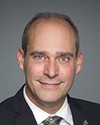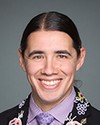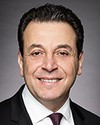We're here to discuss Bill C-2, an act to amend the Income Tax Act. The bill has three main components; first, changes to the personal income tax rates; second, changes consequential to the introduction of the new top marginal income tax rate; and third, restoring the TFSA to its previous level.
I'll first describe the personal income tax rate changes.
These amendments are in clause 1 of the bill.
First, this amendment reduces the second personal incomes tax rate to 20.5% from 22%. This reduced rate would take effect on January 1, 2016. For the 2016 taxation year, it would apply to income earned in excess of $45,282 and up to $90,563. These bracket thresholds are indexed to inflation for subsequent taxation years.
Second, this amendment introduces a new 33% personal income tax rate. This tax rate would apply to individual taxable income in excess of $200,000 and would take effect on January 1, 2016. As with the other bracket thresholds, the $200,000 threshold would be indexed to inflation.
A number of income tax rules either use the top personal income tax rate or use rates or formulas that reflect it. Clauses 2 to 8 and also 10 of the bill contain consequential amendments to a number of provisions that relate to the top marginal rate. In addition, the federal budget tabled on March 22 announced a number of additional consequential amendments to be introduced in a future bill.
Individuals who make charitable donations to registered charities and other qualified donees may be eligible to claim a federal charitable donation tax credit. Annual donations of up to $200 are entitled to a 15% tax credit rate. Donations in excess of $200 are currently entitled to a 29% tax credit rate.
For gifts made after 2015, clause 3 of the bill would provide a 33% tax credit for donations in excess of $200 to the extent that donors have income in the new top income tax rate bracket. Under the income tax rules, a special tax applies at the highest marginal tax rate to so-called split income paid or payable to a minor. In general terms, this tax is intended to prevent individuals who are taxed at the top marginal rate from diverting certain types of income to their children to be taxed at much lower rates.
Effective for the 2016 and subsequent taxation years, clauses 3 and 4 provide that the tax on split income will remain subject to the flat top rate taxation but at the new rate of 33%. Trusts, other than qualified disability trusts, and estates, other than graduated rate estates, currently pay tax at the top federal marginal tax rate applicable to individuals. Effective for the 2016 and subsequent taxation years, clause 5 provides that trusts and estates that are subject to this flat top rate taxation would be taxed at the new top rate of 33%.
Given that corporate tax rates generally are lower than personal tax rates, special refundable taxes are imposed on investment income of private corporations in order to limit the ability of individuals to defer taxation by holding investments in a private corporation. Clauses 6 to 8 provide that these refundable taxes and the related refund rate be increased effective January 1, 2016 to reflect the proposed new 33% personal income tax rate.
Most significantly, the refundable additional part 1 tax on investment income of Canadian-controlled private corporations often called CCPCs would be increased by four percentage points from 6 2/3% to 10 2/3%. The refundable portion of part 1 tax on investment income of CCPCs would be increased by four percentage points from 26 2/3% to 30 2/3%. The refundable part 4 tax on portfolio dividends received by private corporations would be increased by five percentage points from 33 1/3% to 38 1/3%. The rate at which refunds are made out of a private corporation's pool of refundable taxes previously paid, known as refundable dividend tax on hand, would be increased by five percentage points when it pays dividends. This is from 33 1/3% to 38 1/3% of dividends paid.
Finally, clause 9 of the bill returns the TFSA annual contribution limit to its previous level of $5,500 from $10,000 and reinstates indexation of the TFSA annual contribution limit. These changes would be effective for the 2016 and subsequent taxation years and would not affect the $10,000 limit for 2015.
That's all. We'd be happy to answer any questions.












